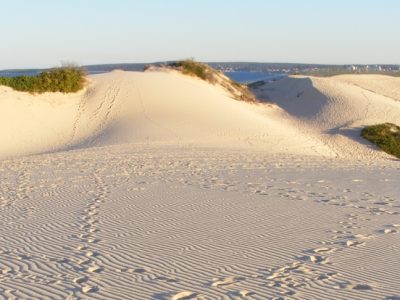KURNELL DUNES

The Kurnell Dunes. (photo source: Teda Inc.)
In my first year of high school my Maths teacher decided to take a group of us on an excursion to Kurnell. We travelled by tram (yes, tram) from Bondi to the city, then train to Cronulla before commencing to hike to Kurnell. We returned home via the then existing ferry across the entrance of Botany Bay to La Perouse and back to Bondi by tram. Such a memorable trip. The highlight was climbing and sliding on the mobile dunes of the Kurnell Isthmus. It was my first encounter with sand dunes with its huge slipfaces that towered over us boys. My imagination ran riot and I envisaged these dunes marching north across the Bay and engulfing Sydney. Well in one way this has happened as sands from these dunes have been mined and used to make the towering structures and other buildings of Sydney.
Paul Farrell wrote an article in the Guardian on 27 December on the history of what he termed the Cronulla dunes. He described how they have been farmed, mined, filmed and now built over. On that first visit our teacher failed to mention much of this history, his main concern was to ensure our survival. But he could have told us that the epic 40000 Horseman was filmed here in 1938 (as was some of Mad Max: Beyond the Thunderdome in 1985). The early colonial settlers soon cleared the dune forest for grazing sheep and cattle triggering activation of the dunes. From the 1930s until now these sands have been a source for the construction industry. Massive amounts have been removed even to the extent that mining has proceeded below the water table in places. The lowering of the surface has worried many on Sutherland Shire Council in fear of a massive break through by wave surge across the Isthmus cutting off access to Kurnell township.
More recently approval has been granted by State authorities and the courts for housing developments on remnants of the once vast dune field. More approvals are pending. For many this is a better outcome than industrial development although the preferred option of parkland could not be funded as it could have required massive compensation to existing landholders. It is going to be interesting to see how the housing estate is managed in future as the site is highly exposed to waves and winds from the south across Bate Bay. Kurt Laboyrie and others of the NSW Soil Conservation Service have done an excellent job in reconstructing foredune vegetation behind the beach and one can only hope that there will be a sustained program of foredune maintenance and improvement to provide the necessary buffer to extreme storm events now the housing estates are there.
My more recent fascination with these dunes has been in its geomorphic history. Years ago I sampled buried charcoal in dunes on the Kurnell Headland to the east of the dunefield. This was my first attempt at dating cliff top dunes and the age showed a degree of dune transgression as sea level was rising about 8000 years ago. But later Peter Roy and Liz Crawford undertook a comprehensive study of the geological evolution of the area ( Records of the Geological Survey of NSW, Volume 20, Part 2, pp.159-250, 1980). This is a momentous work. They were able to reconstruct the Late Quaternary history in some detail, especially the origin of the sand body that formed the Kurnell dunefield. One point that stands out is the morphostratigraphic relationship of the mid-Holocene beach ridges to the transgressive barrier dunes some of which at the time they mapped the area were stable and other sections were mobile. It is rewarding to have such documentation of a sedimentary record for a rich part of Sydney’s Quaternary sequence which now has been mostly lost to science.
I enjoy taking students and visitors to the Kurnell dune area. It forms a small part of my regular Cape to Cape field trip (Cape Banks to Cape Solander via Ramsgate). Every time I do this trip I am reminded of that Maths teacher and just how brave (or crazy) he was letting a bunch of 13 year old boys lose in those dunes. Yet it had an impact on me. I was hooked on coastal dunes!
Words by Prof Bruce Thom, please respect Bruce Thom’s thoughts and reference where appropriately: (c) ACS, 2016, posted 10th January 2016, for correspondence about this blog post please email admin@australiancoastalsociety.org.


